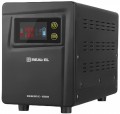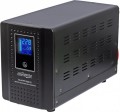Type
—
Standby. The simplest type of UPS, familiar to most ordinary users. Its main purpose is the ability to “softly” shut down work in case of power problems. When the voltage level is normal, the UPS supplies power to the load from the mains, and when the voltage drops or fails, it switches to its own battery. The resource of this battery is usually small — on the order of several minutes, which is usually enough only to save data. Also, such UPSs can smooth out short-term power surges, however, if such surges occur constantly, this wears out the battery and adversely affects the source itself. Redundant UPSs are widely used in home and office environments, they are usually of low power.
—
Smart. A kind of development of the idea of backup UPS; such sources not only provide power in case of a decrease or loss of voltage in the network — they also play the role of voltage stabilizers. The design of such UPSs includes a special regulator (usually in the form of a transformer) that compensates for changes in input voltage and supplies a stable voltage to the output. This allows you to supply constant voltage to the load without the use of batteries, making such blocks well suited for operation in networks with unstable voltage — they not only protect the load, but also do not wear out themselves. Interactive UPSs also mostly have low power and battery capacity and are used to protect individual devices.<
...br>
— Inverter (online). Another name is "double conversion". The most advanced type of UPS providing the highest degree of protection. The name comes from the inverter — an output voltage generator that directly supplies power to the load. The inverter itself simultaneously receives power from two sources — from the network and from a charged battery. In the event of a critical decrease or loss of voltage in the network, the inverter continues to supply energy, only from the battery. Such a scheme avoids voltage surges when switching from the mains to the battery (which is a serious drawback of the two types of UPS described above and can even damage the especially sensitive electronics connected to them). Inverter UPSs have the highest power (up to the ability to power an entire building) and can be designed for a three-phase connection (see "Input voltage"), and some models allow you to select batteries of different capacities, depending on specific needs. On the other hand, inverter UPSs are not very efficient, noisy and expensive, so they are mainly used when high power or advanced protection is critical.
— Low voltage. Miniature UPS for low-voltage electronics backup. Mini devices provide a low voltage DC output (typically 9V, 12V, 15V, or 18V). Traditional sockets are not provided for in their design, and you can usually connect one consumer to them. For example, when there is a power outage from a backup mini-UPS, a short-term autonomous power supply is established for the router (for up to one hour), security systems.Input voltage range
In this case, the input voltage range is implied, in which the UPS is able to supply a stable voltage to the load only due to its own regulators, without switching to the battery. For redundant UPSs (see "Type") this range is quite small, approximately 190 to 260 V; for interactive and especially inverter ones, it is much wider. Some UPS models allow you to manually set the input voltage range.
Max. current
The maximum current drawn by the UPS. In fact, the current reaches its maximum value only when the UPS is operating from the mains with maximum load power and a completely discharged battery. However, when calculating the load on the power grid, this parameter should be taken into account.
Bypass (direct connection)
Bypass(by-pass) means such a mode of operation of the UPS, in which power is supplied to the load directly from an external source — the mains, diesel generator, etc. — practically without processing in the UPS itself. This mode can be activated either automatically or manually.
— The automatic bypass is a kind of safety measure. It turns on when the UPS in normal mode cannot supply power to the load — for example, when the UPS is overloaded due to a sharp increase in the power consumption of the load.
— Manual bypass allows you to enable this mode at the request of the user, regardless of the operating parameters. This may be necessary, for example, to hot-swap a battery (see below for details) or to start equipment that has a starting capacity greater than that of the UPS. Technically, it can also play the role of a security measure, but automatic systems are more reliable in this sense.
Some UPSs provide both options for enabling the bypass.
Efficiency
Efficiency (coefficient of performance) in the case of a UPS is the ratio of its output power to the power consumed from the network. This is one of the main parameters that determine the overall efficiency of the device: the higher the efficiency, the less energy the UPS wastes (due to heating parts, electromagnetic radiation, etc.). In modern models, the efficiency value can reach 99%.
Output frequency
The frequency (frequency range) of the AC voltage output by the UPS. For computer technology, the frequency range of 47-53 Hz is considered normal, although the smaller the deviation from the 50 Hz standard, the better. On the other hand, in some UPS models, this frequency can be automatically synchronized with the frequency of the mains — so the power supplied to the load will not differ regardless of whether the load is powered by the mains or from the battery. In this case, a wider frequency range, on the contrary, is more desirable.
Min. charging current
The lowest current value in Amperes at which the UPS battery can be effectively charged. Note that charging with low currents is considered more gentle and extends the service life of the battery, but this increases the duration of the charging process. The optimal charge current is about 10% of the battery capacity.
Max. charging current
The maximum current in Amperes that charges the UPS battery or battery pack. Frequent charging cycles with high currents reduce the battery's service life. However, charging in this mode will come in handy during regular power outages - it makes sense to use
high charging currents when you need to charge the batteries as quickly as possible while the power is on and be fully prepared for the next power outage.
Charging current regulation
Charging current regulation provides optimal conditions for replenishing energy reserves in the UPS battery cells. In uninterruptible power supply models with a similar function, a charge controller is installed with the ability to change the output current depending on the battery used. And in some UPS systems, automation can not only initially select the optimal current strength, but also regulate it during the charging process depending on the condition of the battery, providing the most gentle charging mode. This increases the efficiency of the charging process, helps extend the battery life and avoid damage.

